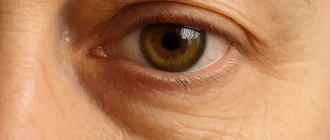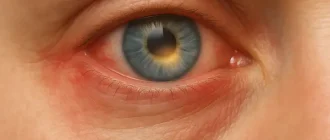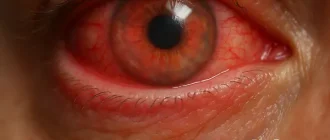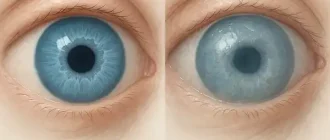Injuries, diseases, or infections that result in a scarred cornea can interfere with the proper transmission of light to the retina, causing vision that is unclear or warped. Corneal ailments, such as keratitis, may additionally induce symptoms such as discomfort, redness, and increased light sensitivity.
Although some injuries or infections affecting the cornea may recover without medical assistance, more severe incidents can result in sustained harm. Hence, it is crucial to consult a medical professional if you encounter any symptoms related to your eyes like pain or unclear vision. Besides, some corneal diseases are hereditary, like corneal dystrophies, which bring about indistinct visions and may necessitate a corneal transplant as a remedy.
Infectious keratitis
Infectious keratitis is a sickness affecting the cornea that arises from inflammation caused by a microbe like bacteria, viruses, or fungus. Symptoms of this ailment may include eye soreness, vision changes, eye discharge, and light sensitivity. It is vital to treat infectious keratitis promptly as it can lead to permanent loss of vision or blindness if scarring occurs on the cornea.
Treatment for infectious keratitis typically involves the use of topical or oral antibiotics, antiviral or antifungal medications, or in severe cases, surgery.
Prevention of infectious keratitis can be achieved by maintaining good hygiene habits, protecting the eyes from injury or exposure to harmful substances, and promptly seeking medical attention for any eye-related symptoms.

Non-infectious keratitis
Keratitis that is not infectious happens when the cornea becomes inflamed but there is no presence of a microbial infection. This type of keratitis can occur when the eyes become dry, when the eye is injured, or when there is exposure to irritants or certain chemicals.
Moreover, keratitis that is not caused by an infection can also occur due to autoimmune conditions like rheumatoid arthritis and lupus. Indicators of this type of keratitis consist of pain, redness, sensitivity to light, blurry vision, and excessive tearing. The treatment for non-infectious keratitis may require artificial tears, corticosteroids or other drugs to alleviate inflammation and address underlying medical conditions.
If left untreated, non-infectious keratitis can lead to scarring and vision loss. Regular eye exams can help diagnose and manage this condition.
Keratoconus
Keratoconus is a condition that results in a thin and outward bulging cornea, leading to vision issues like distorted or blurred vision. This condition is typically detected during late adolescence or early adulthood and can be treated through proper management. If not treated, the condition can worsen over time and potentially cause significant loss of vision.
Treatment options include the use of special contact lenses, such as rigid gas permeable lenses, or surgery, such as corneal cross-linking or corneal transplant. Regular eye exams are important for those with keratoconus to monitor changes in vision and adjust treatment as needed. With proper management, however, most people with keratoconus are able to maintain good vision.
Corneal dystrophies
Genetic conditions known as corneal dystrophies affect the clarity of the cornea, causing problems with vision that can range from mild to severe. Some examples of these conditions include Fuchs’ dystrophy, lattice dystrophy, and map-dot-fingerprint dystrophy.
The symptoms of corneal dystrophies can include blurred vision, sensitivity to light, and halos around objects.
Treatment options vary depending on the type and severity of the dystrophy, but can include medications, surgery, or corneal transplant. It is important for individuals with corneal dystrophies to receive regular eye exams and follow the recommended treatment plan to maintain their vision and prevent further damage to their cornea.
Corneal edema
Corneal edema: This is a condition where the cornea becomes swollen due to fluid accumulation. Corneal edema can cause vision loss, a change in one’s glasses prescription, and sensitivity to light.
Corneal edema can have various causes such as trauma, infection, certain medications, and underlying medical conditions like Fuchs’ endothelial dystrophy.
Treatment options include eye drops, antihistamines, and in severe cases, corneal transplantation. Early diagnosis and management of corneal edema are important to prevent permanent vision loss.
Corneal abrasion
This condition occurs when the surface of the cornea is scratched or injured. Symptoms can include eye pain, redness, and sensitivity to light. Treatment may involve eye drops or ointments and, in severe cases, a corneal transplant.
Corneal abrasion is a common eye condition that can be caused by a variety of factors, including accidentally rubbing your eye, getting something in your eye or wearing contact lenses for an extended period of time. When the surface of the cornea is scratched or otherwise damaged, it can cause a range of symptoms, such as eye pain, redness, tearing and sensitivity to light.
Depending on how severe the abrasion is, treatment may involve the use of eye drops or ointments to help reduce inflammation and promote healing. In more serious cases, a corneal transplant may be necessary to replace the damaged tissue and restore vision.
If you think you may have a corneal abrasion, it is important to seek medical attention as soon as possible in order to prevent further damage to your eye and ensure that you receive appropriate treatment.
Corneal ulcers
Corneal ulcers: This type of corneal disease is caused by an open wound on the cornea. Symptoms include eye pain, redness, and discharge from the eye. Corneal ulcers can be treated with antibiotic eye drops or, in severe cases, surgery.
Corneal ulcers can occur as a result of eye injuries, contact lens misuse, or bacterial or fungal infections. It is important to seek medical attention as soon as possible if you suspect that you have a corneal ulcer, as untreated ulcers can cause permanent vision loss.
Your eye doctor will evaluate the ulcer and recommend a treatment plan based on the severity and cause of the ulcer. In addition to medication or surgery, they may also recommend temporarily avoiding contact lenses or other activities that could irritate the eye. With prompt treatment, most people with corneal ulcers make a full recovery.
Dry eye
Dry eye is a common condition that can affect people of all ages. This occurs when the eye is unable to produce enough tears to keep it lubricated properly. Tears are essential for maintaining the health of the eyes, as they help to flush out any debris or foreign substances that may enter the eye. When tears are not produced in sufficient amounts, the eye can become dry and irritated, leading to discomfort and other symptoms.
Symptoms of dry eye may include eye redness, burning or stinging, blurry vision, and sensitivity to light. In some cases, people may also experience watery eyes, as the eyes try to compensate for the lack of tears.
Treatment for dry eye may involve the use of eye drops that help to lubricate the eyes and reduce inflammation. It may also involve making lifestyle changes, such as increasing the humidity in your home or workplace, using a warm compress on your eyes, or taking breaks from tasks that require intense focus on a screen, such as reading or using a computer.
In rare cases, surgery may be necessary to treat severe cases of dry eye. This may involve the insertion of small plugs into the tear ducts to prevent tears from draining away too quickly, or the use of laser treatment to close the ducts altogether.
If you are experiencing symptoms of dry eye, it is important to seek medical attention from an eye care professional. They can help to diagnose the cause of your symptoms and recommend the appropriate course of treatment.
Conjunctivitis
Pink eye, which is also known as conjunctivitis, is a condition that causes the inflammation of the conjunctiva, a delicate layer of tissue that covers the white portion of the eye. There are different causes of conjunctivitis, including bacteria, viruses, irritants, and allergens.
Signs and indications consist of inflammation, discomfort and secretion from the eye. How conjunctivitis is cured is dependent on the reason behind it. When the cause is bacterial, taking antibiotics is usually the course of action, however when it is viral, it will typically self-resolve without any particular medication. In the case of allergic conjunctivitis, antihistamines or steroid eye drops are effective in controlling it.
To prevent the spread of conjunctivitis, it is advisable to steer clear of substances that cause irritation, observe good hygiene practices, and avoid sharing personal items like towels. It is also vital to immediately seek medical attention to avoid any likelihood of more serious eye conditions that may result from neglect, especially with particular kinds of conjunctivitis.
Herpes simplex keratitis
Herpes simplex keratitis is a viral infection that can lead to inflammation of the cornea and various vision complications. Indications may consist of discomfort, redness, and sensitivity to light in the eyes. It can be treated by antiviral medication and eye drops.
If left untreated, herpes simplex keratitis can lead to scarring of the cornea and permanent vision loss. It is important to seek medical attention promptly if you experience any of these symptoms.
The infection can be caused by the herpes simplex virus type 1 (HSV-1) or type 2 (HSV-2), and can be spread through direct contact with the virus, such as by touching a cold sore or genital herpes lesion and then touching your eyes.
If you have a history of herpes infections, it is important to take preventive measures to avoid spreading the virus to your eyes, such as washing your hands frequently and avoiding touching your face. In some cases, surgery may be required to remove scar tissue from the cornea and restore clarity to the vision.
Keratitis sicca
Keratitis sicca, which is commonly referred to as dry eye syndrome, is a condition where the eye fails to generate an adequate amount of tears to maintain proper lubrication. Signs of this condition comprise of soreness, aridity, and vulnerability to light in the eye.
Treatment may involve eye drops, medications, or surgery. Keratitis sicca is a common condition that affects people of all ages. It can be caused by a variety of factors, including aging, hormonal changes, medications, and environmental factors. In severe cases, keratitis sicca can lead to corneal damage and vision loss.
Treatment options may include using artificial tears, taking prescription medications to increase tear production, or undergoing surgery to block tear drainage. Early diagnosis and treatment are important to prevent long-term complications and improve quality of life for those living with this condition.
Keratomalacia
Keratomalacia is an unusual state where the cornea undergoes softening because of insufficient vitamin A. Its indications are unclear eyesight, increased light sensitivity, and the emergence of a scaly, dry look in the eyes.
To address keratomalacia, individuals may receive vitamin A supplements and maintain a nutritious diet. Failure to treat this condition can result in permanent loss of eyesight. The problem commonly arises in developing nations where there is widespread malnourishment. In developed nations, it occurs more often in people with medical conditions that impede nutrient absorption, like Crohn’s disease.
Prevention of keratomalacia involves maintaining a diet rich in vitamin A, which can be obtained through consumption of fruits and vegetables such as carrots, sweet potatoes, and spinach.





